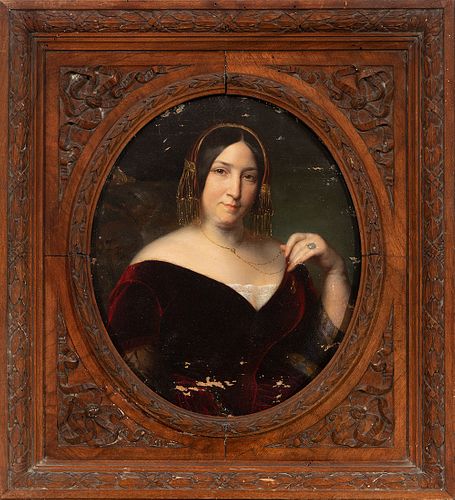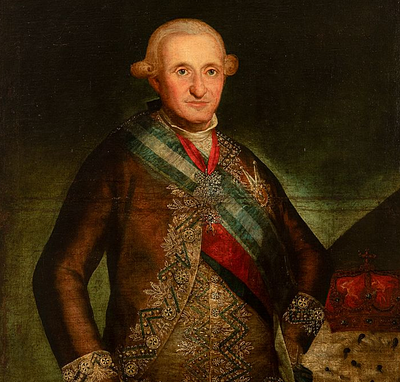Circle of FEDERICO DE MADRAZO Y KUNTZ (Rome, 1815 - Madrid, 1894). "Portrait of a Lady. Oil on canvas.
Lot 51
About Seller
Setdart Auction House
Carrer Aragó 346
Barcelona
Spain
Setdart Subastas was born in 2004 and is currently the first online art auction in Spain with solidity, prestige and reliability guaranteed by our more than 60,000 users. Setdart has a young, dynamic and enterprising team ready to successfully manage the purchase and sale of art works through custom...Read more
Estimate:
EUR€2,000 - EUR€2,500
$2,061.86 - $2,577.32
Absentee vs Live bid
Two ways to bid:
- Leave a max absentee bid and the platform will bid on your behalf up to your maximum bid during the live auction.
- Bid live during the auction and your bids will be submitted real-time to the auctioneer.
Bid Increments
| Price | Bid Increment |
|---|---|
| EUR€0 | EUR€10 |
| EUR€200 | EUR€25 |
| EUR€500 | EUR€50 |
| EUR€1,000 | EUR€100 |
| EUR€3,000 | EUR€200 |
| EUR€5,000 | EUR€500 |
| EUR€10,000 | EUR€1,000 |
| EUR€20,000 | EUR€2,000 |
| EUR€50,000 | EUR€5,000 |
About Auction
By Setdart Auction House
Sep 22, 2021
Set Reminder
2021-09-22 09:30:00
2021-09-22 09:30:00
America/New_York
Bidsquare
Bidsquare : 22nd September - ARAS JÁUREGUI Private Collection - Old Masters, 19th & 20th Century
https://www.bidsquare.com/auctions/setdart-auction-house/22nd-september---aras-j-uregui-private-collection---old-masters-19th-20th-century-7427
ARAS JÁUREGUI Private Collection - Old Masters, 19th & 20th Century Setdart Auction House sofia@setdart.com
ARAS JÁUREGUI Private Collection - Old Masters, 19th & 20th Century Setdart Auction House sofia@setdart.com
- Lot Description
Circle of FEDERICO DE MADRAZO Y KUNTZ (Rome, 1815 - Madrid, 1894). "Portrait of a Lady. Oil on canvas. It presents lack of stretcher, damages, xylophagous remains, repainting and pictorial losses. It has a carved wooden frame, c.1900, with glass. Measurements: 33 x 26,5 cm. The oval, pearly face of the young woman stands out as a unique element of the piece's luminosity. In this portrait, as in the rest of Federico de Madrazo's production, the author emphasises the personality of the protagonist, carrying out a psychological study of the model, in which he shows the woman with great distinction and sobriety. He applies a short, precise brushstroke to the drawing and, despite the fact that it is a cas monochrome portrait, he adds luminosity to the flesh tones and the young woman's gaze. The artist has set the image in an oval of neutral, dark tones to enhance the image. The son of the painter José de Madrazo, who was also in Rome serving Charles IV in exile, Federico de Madrazo moved with his family to Madrid when his father was appointed painter to the court of Ferdinand VII in 1819. Shortly afterwards the Royal Museum of Paintings was inaugurated, an institution that was to play a key role in Federico de Madrazo's life. During his childhood and youth he visited it frequently with his father, who was in fact responsible for the museum's lithographic establishment from 1826 and its director from 1838 to 1857. A precocious painter, Federico de Madrazo joined the San Fernando Royal Academy of Fine Arts as an academician of merit at the age of sixteen. During his youth he founded the magazine "El Artista" with his brother Pedro, which was an important Romantic novelty and in which Federico was responsible for the illustrations. In 1832 he took a scholarship to Paris to study painting with Ingres, a friend of his father's. There he acquired a Romantic style in the style of his father. There he acquired a romantic style in the French manner. In 1840 he continued his training in Rome, where he came into contact with the Nazarenes and in particular with Overbeck, which strengthened his drawing skills, already important in his style thanks to what he had learned from his father and Ingres. An illustrative work of this Nazarene influence on Madrazo is Las Marías en el sepulcro ("The Marys at the Sepulchre"). Two years later he returned to Spain, having become a painter of great prestige, much sought after as a portraitist by the Madrid aristocracy. He was Queen Isabella II's court painter and was the great official portraitist of the time. His portraits were characterised by the simplicity and naturalness of his models, and by a distant serenity, intimately linked to Romantic sentiment. He was also director of the Museo del Prado, a post he held, albeit on an interrupted basis, for thirty years until his death. He also directed the San Fernando Royal Academy of Fine Arts. He had a brilliant career as a history painter and, especially, as a portraitist, achieving great prestige in the artistic circles not only of Madrid but also of Paris and Rome. His production evolved from a painting dominated by purism of line and painstaking detail towards a more fluid and spontaneous technique, with greater expressive depth. Federico de Madrazo is currently represented in the Museo del Prado, the Museo Nacional del Palacio de Versalles, the Museo de Bellas Artes in Bilbao, the Fundación Lázaro Galdiano and the Museo Romántico in Madrid, among others.
- Shipping Info
-
In-house shipping available. Please inquire at admin@setdart.com.
-
- Buyer's Premium



 EUR
EUR CAD
CAD AUD
AUD GBP
GBP MXN
MXN HKD
HKD CNY
CNY MYR
MYR SEK
SEK SGD
SGD CHF
CHF THB
THB














